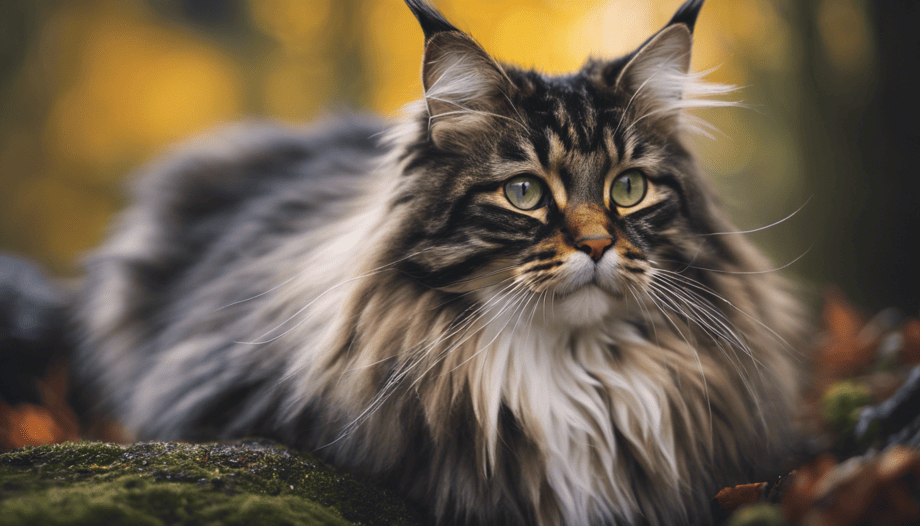The Secret Lives of Outdoor Norwegian Forest Cats

Outdoor Norwegian Forest Cats are majestic and mysterious creatures of the dense Norwegian forest. They embody untamed beauty and silent wisdom in their graceful movements. Witness their true essence unfold under the moonlight, revealing ancient instincts intertwined with modern companionship.
Hunting Instincts and Prey Selection
Exhibiting a potent blend of ancestral prowess and contemporary adaptation, Norwegian Forest Cats actively demonstrate their hunting instincts and varied prey selection in their outdoor pursuits. These feline predators possess a remarkable set of skills that enable them to thrive in outdoor environments. Their hunting instincts, finely tuned over generations, are on full display as they stalk through the wilderness, targeting small rodents like mice, birds, insects, and even fish.
The diverse prey selection of Norwegian Forest Cats not only showcases their predatory instincts but also highlights their adaptability and resourcefulness. With agile movements and sharp senses, these cats strategically choose their prey, reflecting a deep understanding of their surroundings. Their ability to navigate the outdoor terrain with stealth and precision further emphasizes their prowess as skilled hunters. Through their hunting expeditions, Norwegian Forest Cats reveal a glimpse of their wild ancestry and the survival instincts that have been ingrained in their nature.
Climbing Mastery: Trees and Heights
Norwegian Forest Cats exhibit remarkable agility and fearlessness when it comes to climbing trees and exploring heights. Their adeptness at navigating tree branches allows them to move with precision and grace, showcasing their natural affinity for elevated environments.
Observing these felines effortlessly scale trees highlights their innate climbing skills and their adventurous spirit in outdoor settings.
Tree-Dwelling Agility Skills
With remarkable finesse and instinctual prowess, Norwegian Forest Cats effortlessly navigate the intricate network of tree branches, showcasing their mastery of heights and agility. Their tree-climbing skills are a true marvel to behold, as they use their muscular bodies and strong legs to ascend to impressive heights with ease.
These agile felines exhibit a deep connection to their arboreal landscape, moving with grace and balance as they explore their tree-dwelling abilities. It’s fascinating to observe how their wild ancestry plays a role in their natural adaptation to outdoor environments, allowing them to perch on tree limbs confidently and survey their surroundings with a sense of regal poise.
The Norwegian Forest Cat’s ability to maneuver through the treetops highlights their exceptional agility and affinity for heights.
Fearless Heights Exploration
Fearlessly scaling trees and exploring great heights, the agility and fearlessness of Norwegian Forest Cats in mastering climbing skills is a sight to behold. These natural climbers exhibit unparalleled agility as they navigate heights effortlessly, showcasing their climbing mastery in outdoor adventures.
With their strong and agile bodies, they fearlessly conquer various heights, perching at impressive vantage points with grace and precision. Their innate ability to scale trees reflects their wild and adventurous nature, allowing them to survey their surroundings from elevated positions.
Observing these fearless climbers in action reveals a mesmerizing display of agility and confidence as they fearlessly explore the heights, embodying the true essence of outdoor feline prowess.
Social Interactions and Communication
Engaging in a variety of communication methods, outdoor Norwegian Forest Cats establish social hierarchies and boundaries within their territory. Through body language, vocalizations, and scent marking, these cats convey information about their status and intentions to other felines.
For example, a dominant cat may puff up its fur and arch its back to assert its authority, while a submissive cat might crouch down and avoid direct eye contact. Scent marking, achieved by rubbing their cheeks or spraying urine, helps outdoor Norwegian Forest Cats define their territory and communicate with neighboring cats.
These social interactions are crucial for maintaining order and cooperation within the feline community. By understanding each other’s cues and signals, these cats can navigate their environment effectively and minimize conflicts. In forming loose colonies or groups for hunting and protection, outdoor Norwegian Forest Cats showcase the significance of communication in their everyday lives.
Adaptations to Harsh Weather Conditions
Enduring harsh weather conditions effortlessly, Norwegian Forest Cats showcase remarkable adaptations that enable them to thrive in cold climates. Their coat, specifically designed for insulation and protection, plays a crucial role in their ability to withstand extreme weather. The Norwegian Forest Cat’s thick, water-repellent outer fur combined with the insulating undercoat keeps them warm and dry, even in snowy environments. This double-layered fur acts as a natural barrier against the cold, allowing these cats to navigate the rough weather without issue. Additionally, their sturdy build and protective coat have evolved over time to ensure they can handle the challenges of cold climates effectively. The bushy tails and tufted ears of these cats serve as extra shields against the elements, particularly during the winter months, enhancing their survival in the wild. Here is a table highlighting key features of the Norwegian Forest Cats’ coat adaptation:
| Feature | Description | Importance |
|---|---|---|
| Thick, water-repellent | Outer fur that keeps them warm and dry | Insulation |
| Insulating undercoat | Provides protection against cold temperatures | Barrier |
| Double-layered fur | Acts as a shield in snowy environments | Adaptation |
Territorial Behavior and Marking
Norwegian Forest Cats display territorial behavior through scent marking, utilizing glands on their cheeks and paws to communicate boundaries. By marking objects like scratching posts and trees, they establish territories and convey messages to other cats.
This form of communication aids in attracting mates and deterring potential threats in their outdoor environment.
Scent Marking Behavior
The scent marking behavior of outdoor Norwegian Forest Cats plays a crucial role in establishing territory and facilitating communication with other felines. These majestic cats use scent glands strategically located on their cheeks, paws, and tails to leave their unique scent on objects and areas.
- Scent marking helps reduce conflicts among outdoor cats.
- It assists cats in navigating their expansive outdoor territories more effectively.
- The behavior is more prominent in outdoor cats due to the need to define larger territories.
- Understanding scent marking is vital for cat owners to provide suitable enrichment for their Norwegian Forest Cats.
- Scent marking also serves as a way for cats to communicate their presence to other felines in the area.
Boundary Defense Tactics
Boundary defense tactics in outdoor Norwegian Forest Cats involve a combination of scent marking and visual cues to assert their territory and communicate with other felines. These cats utilize scent glands on their cheeks and paws to mark boundaries, often spraying urine on trees and fences. Additionally, they employ visual cues such as scratching trees and rocks to establish dominance in their outdoor environment.
Communication Through Marking
Engaging in territorial behavior through marking, outdoor Norwegian Forest Cats intricately establish communication channels with their surroundings and fellow felines. These majestic cats rely on marking to convey messages and define their territory boundaries effectively. Here are some key insights into their marking communication:
- Norwegian Forest Cats use scent glands on their faces, paws, and tails to leave pheromone signals.
- Marking behavior aids in reducing conflicts by delineating spaces in the outdoor environment.
- Rubbing cheeks or scratching objects helps create a familiar scent profile.
- Understanding marking behaviors is crucial for interpreting social dynamics among Forest Cats.
- Marking serves as a sophisticated form of non-verbal communication in the feline world.
Nighttime Adventures and Nocturnal Habits
During their nighttime adventures, Norwegian Forest Cats showcase their natural hunting instincts and prowess as skilled nocturnal predators, utilizing their keen senses to navigate and hunt effectively under the cover of darkness. These outdoor felines are more active during the night, using their exceptional sight and hearing to prowl their territory, marking boundaries, and engaging in hunting activities.
Their nocturnal habits are finely tuned to excel in outdoor environments, where they can freely roam and hunt under the veil of night. With a heritage rooted in surviving harsh Scandinavian winters, Norwegian Forest Cats have evolved to thrive in the darkness, making them well-suited for exploring the shadows and seeking out prey when most other creatures are at rest.
Their nighttime adventures not only fulfill their hunting instincts but also provide them with the necessary stimulation and exercise to maintain their physical and mental well-being, ensuring they lead fulfilling lives in the wild.
Playful Antics and Natural Behaviors
As the night fades into day, the playful antics and natural behaviors of outdoor Norwegian Forest Cats come to life, showcasing their agility, curiosity, and innate hunting instincts. These magnificent felines exhibit a range of behaviors that highlight their unique characteristics:
- Climbing trees: Outdoor Norwegian Forest Cats are skilled climbers, effortlessly navigating through branches and perching themselves on high vantage points to observe their surroundings.
- Chasing prey: Their playful antics often involve stalking and chasing after insects or small animals, honing their hunting skills in the process.
- Exploring surroundings: These curious creatures love to explore their outdoor environment, investigating new scents, sights, and hidden nooks with a sense of wonder.
- Sunbathing and rolling in the grass: Enjoying the warmth of the sun, these cats bask in its rays and delight in rolling around in the lush grass.
- Balancing acts: Demonstrating remarkable agility, outdoor Norwegian Forest Cats showcase their athleticism by jumping, running, and balancing on various surfaces with grace and precision.
Through these natural behaviors and playful antics, these cats engage in activities that not only entertain but also fulfill their instincts and provide mental stimulation in their outdoor escapades.
Frequently Asked Questions
Do Norwegian Forest Cats Like to Be Outside?
One can observe that Norwegian Forest Cats truly cherish their time outdoors, reveling in exploring nature, indulging hunting instincts, seeking outdoor adventures, and basking in sunbathing spots. Their outdoor escapades are a testament to their wild spirit.
What Is Special About Norwegian Forest Cats?
Norwegian Forest Cats possess unique traits like their sturdy build and double-layered coat. Their gentle nature and high intelligence set them apart. With a rich history tied to Norse mythology, misconceptions about these cats being wild are dispelled.
What Are the Cons of the Norwegian Forest Cat?
The cons of Norwegian Forest Cats include grooming challenges due to their thick fur, health concerns like genetic disorders and heart conditions, and their high energy levels that require interactive play to keep them mentally and physically stimulated.
Do Norwegian Forest Cats Bond With One Person?
Norwegian Forest Cats often form strong attachments with multiple individuals due to their sociable and affectionate nature. Their loyalty and adaptability allow them to bond with various household members, demonstrating a preference for human connection over exclusivity.











